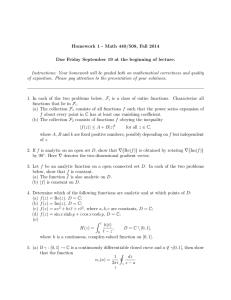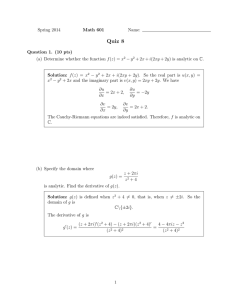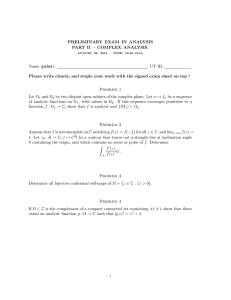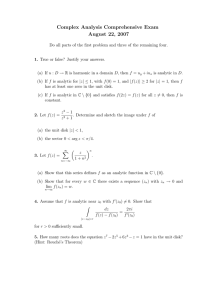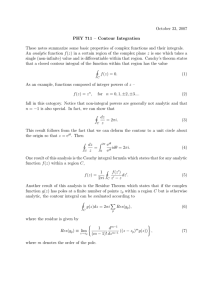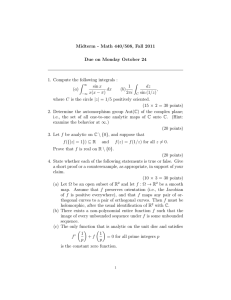Homework #7 Solutions
advertisement
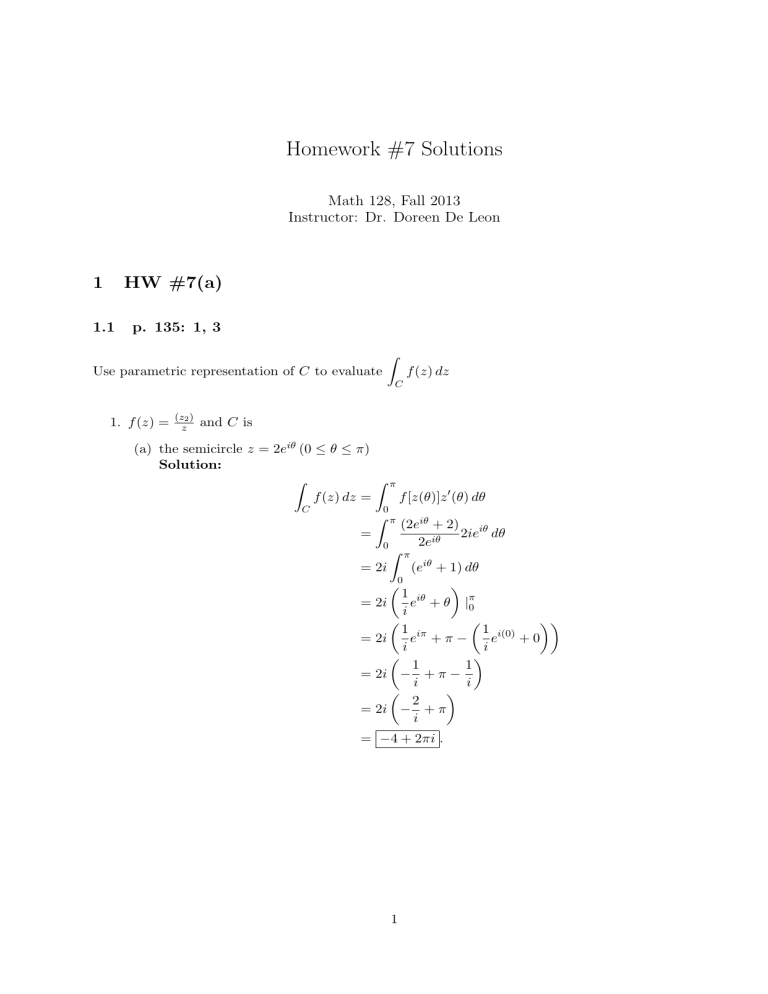
Homework #7 Solutions
Math 128, Fall 2013
Instructor: Dr. Doreen De Leon
1
HW #7(a)
1.1
p. 135: 1, 3
∫
Use parametric representation of C to evaluate
f (z) dz
C
1. f (z) =
(z2 )
z
and C is
(a) the semicircle z = 2eiθ (0 ≤ θ ≤ π)
Solution:
∫
∫ π
f (z) dz =
f [z(θ)]z ′ (θ) dθ
C
0
∫ π
(2eiθ + 2) iθ
=
2ie dθ
2eiθ
0
∫ π
= 2i
(eiθ + 1) dθ
)
(0
1 iθ
= 2i
e + θ |π0
i
(
(
))
1 iπ
1 i(0)
e +π−
e
+0
= 2i
i
i
(
)
1
1
= 2i − + π −
i
i
(
)
2
= 2i − + π
i
= −4 + 2πi .
1
(b) the semicircle z = 2eiθ (π ≤ θ ≤ 2π)
Solution:
∫
∫ 2π
f (z) dz =
f [z(θ)]z ′ (θ) dθ
C
π
∫ 2π
(2eiθ + 2) iθ
=
2ie dθ
2eiθ
π
∫ 2π
= 2i
(eiθ + 1) dθ
π
)
(
1 iθ
e + θ |2π
= 2i
π
i
(
(
))
1 i2π
1 i(π)
= 2i
e + 2π −
e
+π
i
i
(
(
))
1
1
= 2i
+ 2π − − + π
i
i
(
)
2
= 2i
+π
i
= 4 + 2πi .
(c) the circle z = 2eiθ (0 ≤ π ≤ 2π)
Solution: Let C1 be the contour from part (a) and C2 be the contour from part (b).
Then C = C1 + C2 , so
∫
∫
∫
f (z) dz =
f (z) dz +
f (z) dz
C
C1
C2
= (−4 + 2πi) + (4 + 2πi)
= 4πi .
3. f (z) = π exp(πz) and C is the boundary of the square with vertices at 0, 1, 1 + i, and i, the
orientation of C being counterclockwise.
Solution:
1
C4
C3 1 + i
C2
C1 1
So, C = C1 + C2 + C3 + C4 , and a parameterization for the curves is
C1 : z(t) = t, 0 ≤ t ≤ 1 =⇒ z ′ (t) = 1
C2 : z(t) = 1 + (t − 1)i, 1 ≤ t ≤ 2 =⇒ z ′ (t) = i
C3 : z(t) = (3 − t) + i, 2 ≤ t ≤ 3 =⇒ z ′ (t) = −1
C4 : z(t) = (4 − t)i, 3 ≤ t ≤ 4 =⇒ z ′ (t) = −i
2
Integrate f (z) along each contour.
∫
∫
1
f [z(t)]z ′ (t) dt
f (z) dz =
C1
0
∫
1
πeπt · 1 dt
=
=
∫
0
1
eπt 0
π
= e − 1.
∫ 2
f (z) dz =
f [z(t)]z ′ (t) dt
C2
1
∫
2
π exp(π(1 − (t − 1)i))i dt
=
1
∫
2
πieπ e−π(t−1)i dt
1
∫ 2
π
=e
πieπ(t−1)i dt
(1
)
2
π
=e
−eπ(t−1)i
1
(
)
π
πi
=e 1−e
=
∫
= 2eπ .
∫ 3
f [z(t)]z ′ (t) dt
f (z) dz =
2
C3
∫
3
π exp(π((3 − t) − i))(−1) dt
=
2
∫
3
=−
πe−πi eπ(3−t) dt
2
=e
−πi
eπ(3−t)
3
2
= −1 (1 − eπ )
∫
= eπ − 1.
∫ 4
f (z) dz =
f [z(t)]z ′ (t) dt
C4
3
∫
4
=
π exp(−π(4 − t)i)(−i) dt
3
∫
4
=
−πieπ(t−4)i dt
3
4
= − eπ(t−4)i
(
)3
= − 1 − eπi
= −2.
3
So,
∫
∫
f (z) dz =
C
∫
∫
f (z) dz +
C1
π
f (z) dz +
C2
∫
f (z) dz +
C3
f (z) dz
C4
= e − 1 + 2eπ + (eπ − 1) − 2
= 4eπ − 4 = 4 (eπ − 1) .
1.2
Problem 2
∫
1
dz, where C is the circle of radius 2 centered at 1, traversed counterclockwise.
(z
−
1)
C
Solution: Parameterization of C : z(θ) = 1 + 2eiθ , 0 ≤ θ ≤ 2π. Then, z ′ (θ) = 2ieiθ . Therefore,
Evaluate
∫
∫
2π
f (z) dz =
C
f [z(θ)]z ′ (θ) dθ
0
∫
2π
=
0
∫
1
2ieiθ dθ
(1 + 2eiθ ) − 1
2π
i dθ
=
0
= iθ|2π
0
= 2πi .
1.3
Problem 3
Evaluate
∫
C
z 2 dz along two paths joining 0 to 1 + i as follows:
(a) C is the straight line segment joining 0 to 1 + i.
(b) C is the union of the line segment joining 0 to 1, then joining 1 to 1 + i.
What do you observe?
Solution: Let f (z) = z 2 .
(a)
1+i
1
1
A parameterization of C is
4
z(t) = (1 + i)t, 0 ≤ t ≤ 1
=⇒ z ′ (t) = 1 + i.
Then,
∫
∫
1
f (z) dz =
C
f [z(t)]z ′ (t) dt
0
∫
1
[(1 + i)t]2 (1 + i) dt
∫ 1
= (1 + i)
(1 − i)2 t2 dt
0
∫ 1
= −2i(1 + i)
t2 dt
=
0
0
t3
= −2i(1 + i)
3
1
= −2i(1 + i)
3
2 2
=
− i.
3 3
1
0
(b)
1
C2
C1
C1 : z(t) = t, 0 ≤ t ≤ 1 =⇒ z ′ (t) = 1
C2 : z(t) = 1 + (t − 1)i, 1 ≤ t ≤ 2 =⇒ z ′ (t) = i Then,
∫
∫
1
f (z) dz =
C1
[t]2 · 1 dt
0
∫
1
t2 dt
=
0
t3
=
3
1
= .
3
5
1
0
∫
∫
2
f (z) dz =
C2
[(1 + (t − 1)i)]2 · i dt
1
∫
2
=i
(1 + (1 − t)i)2 dt
1
∫
2
(1 + 2(1 − t)i − (1 − t)2 ) dt
(1
)
2
1
3
2
= i t − (1 − t) i + (1 − t)
3
1
(
)
1
=i 2−i− −1
3
)
(
2
−i
=i
3
2
= 1 + i.
3
=i
Then,
∫
∫
∫
f (z) dz =
f (z) dz +
C
C1
f (z) dz
C2
2
1
+1+ i
3
3
4 2
=
+ i.
3 3
=
The integrals in (a) and (b) yield different results.
independent.
2
2.1
Therefore, the integral is not path-
HW #7(b)
Problem 1
∫
Find a number M such that
C
dz
≤ M,
+2
z2
where C is the upper half of the unit circle.
Solution:
z2
1
1
≤ 2
+2
|z + 2|
1
≤ 2
|z − (−2)|
1
1
≤
=
= 1.
2
2
||z| − | − 2||
||1| − 2|
Therefore,
∫
C
dz
≤ 1(length of C) = π = M.
+2
z2
6
2.2
p. 141: 4
Let CR denote the upper half of the circle |z| = R (R > 2), taken in the counterclockwise direction.
Show that
∫
2z 2 − 1
πR(2R2 + 1)
dz
≤
.
4
2
(R2 − 1)(R2 − 4)
CR z + 5z + 4
Then, show that the value of the integral tends to 0 as R → ∞.
Solution:
• Find an upper bound on 2z 2 − 1.
|2z 2 − 1| ≤ 2|z|2 + 1
= 2R2 + 1.
• Find a lower bound on z 4 + 5z 2 + 4.
|z 4 + 5z 2 + 4| = |(z 2 − 1)(z 2 − 4)|
= |z 2 − 1||z 2 − 4|
≥ ||z|2 − 1|||z|2 − 4| = (R2 − 1)(R2 − 4).
Therefore,
2z 2 − 1
2R2 + 1
.
≤
z 4 + 5z 2 + 4
(R2 − 1)(R2 − 4)
So,
∫
CR
2z 2 − 1
2R2 + 1
dz
(length of CR )
≤
z 4 + 5z 2 + 4
(R2 − 1)(R2 − 4)
=
πR(2R2 + 1)
.
(R2 − 1)(R2 − 4)
As R → ∞,
∫
CR
2z 2 − 1
πR(2R2 + 1)
dz
≤
lim
=0
R→∞ (R2 − 1)(R2 − 4)
z 4 + 5z 2 + 4
CR
2z 2 − 1
dz = 0
z 4 + 5z 2 + 4
0 ≤ lim
R→∞
∫
=⇒ lim
R→∞
2.3
p. 149: 1, 2
1. Use an antiderivative to show that for every contour C extending from a point z1 to a point
z2 ,
∫
)
1 ( n+1
z n dz =
z2 − z1n+1 (n = 0, 1, 2, . . . ).
n+1
C
7
Solution:
∫
∫
n
z2
z dz =
C
z n dz
z1
z
z n+1 2
=
n+1
z2n+1
=
z1
−
z1n+1
n+1
n+1
)
1 ( n+1
=
z2 − z1n+1 .
n+1
2. By finding an antiderivative, evaluate each of these integrals, where the path is any contour
between the indicated limits of integration.
∫ i
2
eπz dz
(a)
i
Solution:
∫
i
2
i
∫
π+2i
cos
(b)
0
(z )
2
i
e
πz
2
1
dz = eπz
π
i
)
1 ( i( π )
=
e 2 − eiπ
π
1
= (i + 1).
π
dz
Solution:
∫
π+2i
cos
0
(z )
2
dz = 2 sin
(z )
π+2i
2 0
)
π + 2i
= 2 sin
− 2 sin 0
2
(π
)
= 2 sin
+i
[ (2π )
(π )
]
= 2 sin
cos i + cos
sin i
2
2
= 2 cos i
)
( 2
2
ei − e−i
=2
2
(
= e−1 + e.
(c)
∫3
(z − 2)3 dz
Solution:
1
∫
1
3
3
1
(z − 2)4
4
1
1
1
4
= (3 − 2) − (1 − 2)4
4
4
= 0.
(z − 2)3 dz =
8
3
HW #7(c)
3.1
p. 160: 1(b), (c), (f )
Apply the Cauchy-Goursat Theorem to show that
circle |z| = 1, in either direction, and when
∫
C
f (z) dz = 0, where the contour C is the unit
(b) f (z) = ze−z
Solution:
f (z) = ze−z is entire =⇒ f is analytic on and inside the contour C. Therefore,
∫
ze−z dz = 0.
C
1
+ 2z + 2)
Solution: f (z) is analytic for all z except where z 2 + 2z + 2 = 0 =⇒ z = −1 + i, −1 − i.
Neither of these points is on or inside C. Therefore, f is analytic on and inside the contour
C
∫
z
dz = 0.
=⇒
2
C (z + 2z + 2)
(c) f (z) =
(z 2
(f) f (z) = Log (z + 2)
Solution: Log (z) is analytic everywhere except the set {(x, y)|x ≤ 0 and y = 0}, and
w = z + 2 is entire. Note that w = (x + 2) + iy. Therefore, Log (z + 2) is analytic everywhere
except the set
{(x, y)|x + 2 ≤ 0 and y = 0} = {(x, y)|x ≤ −2 and y = 0}.
The set where f is not analytic is not on or inside C =⇒ f is analytic on and inside C
∫
=⇒
Log (z + 2) dz = 0.
C
3.2
p. 161: 2(a), (c)
Let C1 denote the positively oriented boundary of the square whose sides lie along the line x =
±1, y = ±1 and let C2 be the positively oriented circle |z| = 4. Show that
∫
∫
f (z) dz =
f (z) dz,
C1
C2
where
(a) f (z) =
1
+1
3z 2
Solution:
9
4
C2
C1
-1
×
×
1
-4
f (z) =
1
is analytic for all z except where 3z 2 + 1 = 0 =⇒ f is analytic for all
+1
3z 2
1
z ̸= ± √ .
3
So, f is analtyic on C1 and C2 and between C1 and C2 . Therefore, by the Path Deformation
Principle,
∫
∫
1
1
dz =
dz.
2
2
C1 3z + 1
C2 3z + 1
z
1 − ez
Solution: f (z) =
(c) f (z) =
z
is analytic for all z such that
1 − ez
1 − ez ̸= 0
=⇒ ez ̸= 1
But,
ez = 1
=⇒ ex eiy = 1ei0
=⇒ x = ln 1 and y = 0 + 2nπ, n ∈ Z.
Therefore, f is analytic for
z ̸= 2nπi, n ∈ Z.
So, f is analytic for z = 0, ±2πi, ±4πi, . . . =⇒ f is anlytic on C1 and C2 and between C1
and C2 . Therefore,
∫
∫
z
z
dz
=
dz.
z
1
−
e
1
−
ez
C2
C1
3.3
Problem 3
Evaluate the following
∫
(z 3 + 3) dz, where C is the upper half of the unit circle traversed counterclockwise.
(a)
C
10
C1
-1
-1
1
1
So,
∫
∫
(z 3 + 3) dz =
C
=
−1
1
z4
4
1(z 3 + 3) dz
−1
+ 3z
1
= −6 .
∫
(z 3 + 3) dz, where C is the unit circle traversed clockwise.
(b)
C
Solution: f (z) = z 3 + 3 is entire, and so is analytic on and inside C. Therefore, by the
Cauchy-Goursat theorem,
∫
(z 3 + 3) dz = 0.
C
∫
1
e z dz, where C is the circle of radius 3 centered at 1 + 5i traversed counterclockwise.
(c)
C
×
1
is analytic for all z ̸= 0 and ez is entire. z0 = 0 is not on
z
1
or “inside” C, so e z is analytic on and inside C. Therefore,
∫
1
e z dz = 0
1
e z is analytic for all z ̸= 0, because
C
by the Cauchy-Goursat theorem.
)
(
∫
1
dz, where C is the unit square with corners at 0, 1, 1 + i, and i, traversed
(d)
cos 3 +
z−3
C
clockwise.
Solution:
11
1
C
1
2
×
3
(
f (z) = cos 3 +
)
1
is analytic for all z ̸= 3 =⇒ f is analytic on and inside C. So, by the
z−3
Cauchy-Goursat theorem,
(
)
∫
1
cos 3 +
dz = 0.
z−3
C
12
